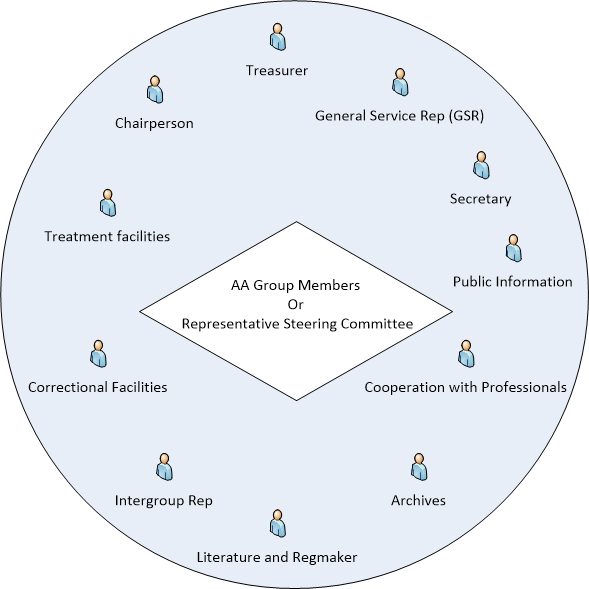Services
Our Twelfth Step—carrying the message—is the basic service that the A.A. Fellowship gives; this is our principal aim and the main reason for our existence. Therefore, A.A. is more than a set of principles; it is a society of alcoholics in action. We must carry the message, else we ourselves can wither and those who haven’t been given the truth may die.
Hence, an A.A. service is anything whatever that helps us to reach a fellow sufferer—ranging all the way from the Twelfth Step itself to a ten-cent phone call and a cup of coffee, and to A.A.’s General Service Office for national and international action. The sum total of all these services is our Third Legacy of Service.
Services include meeting places, hospital cooperation, and intergroup offices; they mean pamphlets, books , and good publicity of almost every description.They call for; committees, delegates, trustees, and conferences.And, not to be forgotten, they need voluntary money contributions from within the Fellowship.

Vital to A.A.’s Growth

These services, whether performed by individuals, groups, areas, or A.A. as a whole, are utterly vital to our existence and growth. Nor can we make A.A. more simple by abolishing such services. We would only be asking for complication and confusion.
Concerning any given service, we therefore pose but one question: “Is this service really needed?” If it is, then maintain it we must, or fail in our mission to those who need and seek A.A.
What Do A.A. Group Members Do?
“I am responsible . . . when anyone, anywhere, reaches out for help, I want the hand of A.A. always to be there. And for that I am responsible.” In short, when newcomers walk into our meeting rooms, we want A.A. to be there for them as it was for us—something we can do continuously only if we function as a group. But, for a group to keep going, all kinds of service must be done. It is through the combined efforts and ongoing commitment of group members that:
- Calls for help are answered.
- Group problems are aired and resolved.
- Assistance in finding A.A. meetings is given to alcoholics in the area.
- Continuing contact is sustained with the rest of A.A.—locally, through the intergroup (central office), district and area’s general service structure; and nationally and internationally, through the General Service Office in New York.
What Trusted Servants (Officers) Do We Need?
It takes member participation to ensure that group service work is done. Most of us agree that A.A. ought never be “organized.” However, without endangering our commitment to preserve our spiritual and democratic Fellowship, we can “create service boards or committees directly responsible to those they serve.” (Tradition Nine) In A.A. groups, these trusted servants are sometimes called “officers” and usually are chosen by the group for limited terms of service. As Tradition Two reminds us, “Our leaders are but trusted servants; they do not govern.”
Each group determines the minimum length of sobriety for A.A. members to be eligible for any position (or office). The general guideline might be stable sobriety of six months to a year, or longer.
These service positions may have titles. But titles in A.A. do not bring authority or honor; they describe services and responsibilities. And it has generally been found that giving members service positions solely to help them stay sober does not work; instead, the group’s welfare is of primary concern in choosing officers. At election time, a review of Traditions One and Two can be helpful.
Individual groups have many ways of making sure that the necessary services are performed with a minimum of organization. The chart below shows possibilities for service at the group level.

General service representative (G.S.R.)

Working via the district and area committees, the G.S.R. is the group’s link with the General Service Conference, through which groups share their experience and voice A.A.’s collective conscience. Sometimes called “the guardians of the Traditions,”
G.S.R.s become familiar with A.A.’s Third Legacy—our spiritual responsibility to give service freely. Usually elected to serve two-year terms, they:
- Represent the group at district meetings and area assemblies.
- Keep group members informed about general service activities in their local areas.
- Receive and share with their groups all mail from the General Service Office, including the newsletter AA in SA, which is G.S.O.’s primary tool for communicating with the Fellowship.
An alternate G.S.R. is elected at the same time in the event that the G.S.R. may be unable to attend all district and area meetings. Alternate G.S.R.s should be encouraged to share the responsibilities of the G.S.R. at the group, district and area levels. (See The A.A. Service Manual, Chapter 2, The Group and its G.S.R., for further information.)
Financial Support: Current experience indicates that many groups provide financial support for their general service representatives to attend service functions.
Chairperson:
Group chairpersons serve for a specified period of time (usually six months to a year). Experience suggests that they should have been sober a while, at least a year; and ideally, they have held other group offices first. The chairperson coordinates activities with other group officers—and with those members who assume the responsibility for literature, hospitality, coffee making, programming individual meetings within the group, and other vital functions.
The more informed that chairpersons—and other group officers—are about A.A. as a whole, the better they function.
By keeping Tradition One firmly in mind and encouraging members to become familiar with all the Traditions, they will help to ensure a healthy A.A. group.

Secretary:

Like chairpersons, secretaries need to be good all-around group servants. For groups that have no chairpersons, they may perform the tasks associated with that position. While each group has its own procedures, the secretary is generally expected to:
- Announce and/or mail information about important A.A. activities and events.
- Maintain minutes of business meetings.
- Keep a record of members’ sobriety dates, if the group so wishes.
- Maintain a bulletin board for posting A.A. announcements, bulletins and newsletters.
- Accept and assign calls for Twelfth-Step help (unless there is a Twelfth-Step chairperson for this task).
- Share with group members the mail from other groups and the intergroup (central office), unless this is done by the intergroup representative.
- Maintain and update a strictly confidential file of names, addresses, and telephone numbers of group members (subject to each member’s approval); and know which members are available to visit still-suffering alcoholics (Twelfth-Step calls).
Treasurer:
A.A. groups are fully self- supporting through their members’ voluntary contributions.
Passing the basket at meetings usually covers the group’s monetary needs, with enough left over so the group can do its fair share of supporting the local inter-group (central office), the general service district and area offices, and the General Service Office. Group funds ordinarily are earmarked for such expenses as:
- Rent
- A.A. literature
- Coffee and refreshments
- Support of all A.A. service entities, usually on a monthly or quarterly basis.
- Local meeting lists, usually purchased from your nearest inter-group (central office), general service district or area committee


Treasurers generally maintain clear records (a ledger is helpful) and keep their groups informed about how much money is taken in and how it is spent.
They may make periodic reports to the group and post financial statements quarterly. Problems can be avoided by keeping group funds in a separate group bank account that requires two signatures on each check. The flyer “The A.A. Group Treasurer” offers many other helpful suggestions.
A.A. experience clearly shows that it is not a good idea for a group to accumulate large funds in excess of what is needed for rent and other expenses. It is wise, though, to keep a prudent reserve in case an unforeseen need arises (an amount to be determined by the group conscience). Group troubles also may arise when extra-large donations—in money, goods or services— are accepted from one member.
The Conference-approved pamphlet “Self- Support—Where Money and Spirituality Mix” makes suggestions as to how groups may support A.A. services.
Additionally, G.S.O., area and sometimes district committees and your local intergroup accept contributions from individual A.A. members. A.A. members are free to contribute whatever they wish, within the limits set by A.A. service entities.
Literature Reps
Today, as in the early days of Alcoholics Anonymous, the A.A. message of recovery from alcoholism is carried by one alcoholic talking to another.
However, since the publication of the first edition of the Big Book in 1939, literature has played an important role in spreading the A.A. message and imparting information about the A.A. Twelve Step program of recovery.
A.A. co-founder Bill W., who often called the influence of A.A. literature “incalculable,” wrote in the May 1964 issue of the Grapevine, “Suppose, for instance, that during the last twenty-five years A.A. had never published any standard literature…no books, no pamphlets. We need little imagination to see that by now our message would be hopelessly garbled. Our relations with medicine and religion would have become a shambles. To alcoholics generally we would today be a joke and the public would have thought us a riddle. Without its literature, A.A. would certainly have bogged down in a welter of controversy and disunity.” (The Language of the Heart, p. 348) Bill’s words ring just as true today.


The newcomer, walking into an A.A. group for the first time, may be given a meeting list, basic recovery pamphlets and, depending on the individual group conscience, perhaps a copy of Living Sober or the Big Book.
BASIC FUNCTIONS
- Provide literature for groups, area, and district functions.
- Become familiar with the information on G.S.O.’s A.A. Web Site (www.aa.org).
- Inform groups, district or area assembly members, through displays and other suitable methods, of all available Conference-approved literature, audiovisual material and other special items.
- Consider suggestions regarding proposed additions to and changes in Conference-approved literature and audiovisual material.
- Encourage A.A. members to read and purchase A.A. Conference approved literature.
Treatment Facilities (TF)
In trying to reach the alcoholic who is in a treatment facility or rehab, A.A.s work together, insofar as possible, by using suggestions from those who have had experience carrying the message into treatment facilities.
Treatment facilities committees are formed to coordinate the work of individual A.A. members and groups who are interested in carrying our message of recovery to alcoholics in treatment facilities, and to set up means of “bridging the gap” from the facility to an A.A. group in the individual’s community. A treatment facilities committee may function within the structure of a general service committee on the area or district level or it may serve within the structure of a central office/intergroup. Prior to forming these committees, this Twelfth Step work is sometimes handled by an individual group or member.
As A.A. groups grow in number in a community, experience suggests that a committee works more effectively. In some parts of the country, A.A.s interested in carrying the message into treatment and correctional facilities work together on Hospitals and Institutions committees independent of, but in cooperation with, general service and intergroup committees. This structure also works well—especially in areas where lines of communication between the various service entities remain open.
Since A.A.’s co-founders first stayed sober by carrying the A.A. message into hospitals, many other alcoholics have discovered the great value to their own sobriety of working with suffering alcoholics in treatment facilities.


In 1934, Bill W. kept trying to help drunks in Towns Hospital in New York City. None of them seemed interested at that time, but Bill stayed sober. Dr. Bob worked with thousands of alcoholics at St. Thomas Hospital in Akron, Ohio. In 1939, Rockland State Hospital, a New York mental institution, was the site of one of our first A.A. hospital groups.
Today many A.A. meetings take place in treatment facilities all over the world. Twelfth Stepping and sponsoring other alcoholics — where they are—has long been one of the most important and satisfying ways of keeping ourselves sober.
The basic functions of the Treatment facilities committees include:
- With approval of administration, takes A.A. meetings into facilities within its area.
- Encourages group participation. In some areas each group has a representative on the T.F. committee.
- Coordinates temporary contact programs.
- Arranges purchase and distribution of literature for these groups and meetings.
Correctional Facilities
Many A.A. members are unaware of the important work being carried out by corrections committees. To those involved, however, corrections work is an opportunity to carry the A.A. message to the confined alcoholic who wants to live sober, one day at a time. Through a corrections committee working with corrections personnel, alcoholics are reached who might never otherwise find the A.A. program.
An active corrections committee is a vital link to prisons and jails, providing professionals and other workers in correctional facilities with information about A.A., literature, and guidelines for setting up A.A. groups on the inside.

Basic Committee functions include:

Corrections committees, when allowed to do so, take A.A. meetings into facilities within their area. They encourage “outside” group participation in this kind of Twelfth Step work. In some areas, each group has a group corrections representative. The committee provides a liaison between the correctional facilities groups and meetings and groups on the outside, and also coordinates prerelease contacts.
The relationship with prison authorities is discussed in the corrections workbook to ensure a positive reciprocal working relationship with administrators and staff. A.A. members wishing to carry our message to alcoholics behind the walls of correctional facilities should understand that we always do so within the regulations of such facilities.
Corrections Committees and Hospital and Institutions (H&I) Committees are encouraged to thoroughly review and understand all procedures of institutions with whom they cooperate, and to share this information with all A.A. members who bring A.A. meetings inside. Some committees make available copies of regulations and forms that must be completed, so that A.A. members new to this service work can review the materials prior to making their decision. Some committees share this information with A.A. members new to corrections service through regular workshops, information sheets, and volunteer packets developed by local trusted servants.
The corrections workbook also goes into detail about prison A.A. meetings. It suggests different ways to shoulder responsibility for meetings and speakers. Most committees find that adequate literature supplies are essential in a correctional facility group or meeting. Supplies are financed and obtained in several ways: Donated by local intergroup or general service committee; donated by members of the committee; purchased with individual contributions; provided by groups through their corrections representatives. Special funds: Buck of the Month Club, where members contribute, and funds are used for corrections literature; special meetings or dinners, at which a collection is taken; special cans at regular meetings, marked “For Corrections Literature.”

Co-operating with the Professional Community (CPC)

Cooperating with nonalcoholic professionals is an effective way to carry the message to the sick alcoholic. Such people often meet the alcoholic in places where A.A. is not present. Through professionals, alcoholics may be reached who might otherwise never find the program, or they may be reached sooner with the help of informed non‑A.A.s.
A professional can be anyone who deals with problem drinkers in the course of their work. Many of these people often encounter the suffering alcoholic, and in spite of public awareness, many of them simply don’t know what to do with a drunk.
- armed forces officer
- athletic coach
- corrections officer
- court official
- educator
- clergyperson
- judge
- law enforcement officer
- professional student
- public health official
- senior services professional
- alcoholism or other counselor
- social worker; union official.
- juvenile services professional
- probation or parole professional
- lawyer (prosecutor, defense attorney)
- employers or employee assistance professionals
- health care professional (doctor, nurse, psychiatrist, psychologist, etc.)


A professional can be a family doctor or other health care professional, a member of the clergy, a law enforcement or court official, an educator, a social worker, an alcoholism or other counselor, or anyone who deals with problem drinkers in the course of their work. Many of these people often encounter the suffering alcoholic, and in spite of public awareness, many of them simply don’t know what to do with a drunk.
C.P.C. work can begin when individual A.A.s reveal their membership to their doctors or drop a quiet word in the ear of a pastor, priest or rabbi that an A.A. member is available to the congregation. Some A.A. members, A.A. groups, or committees share a single issue of the Regmaker with the professionals, explaining how our meeting in print paints a picture of the Fellowship in action through members’ stories and letters. Groups can further participate in C.P.C. by welcoming professionals and future professionals to open meetings and offering a subscription to the Regmaker.
Committees on the area or local level actively seek ways to make contact with professional people and set up programs to increase knowledge and understanding of Alcoholics Anonymous.
Public Information (PI)
Like all of A.A., the primary purpose of members involved with public information service is to carry the A.A. message to the alcoholic who still suffers. Working together, members of local Public Information committees convey A.A. information to the general public, including the media.
In all public relationships, A.A.’s sole objective is to help the still – suffering alcoholic. Always mindful of the importance of personal anonymity, we believe this can be done by making known to the still suffering alcoholics, and to those who may be interested in their problem, our own experience as individuals and as a fellowship in learning to live without alcohol.
We believe that our experience should be made available freely to all who express sincere interest. We believe further that all efforts in this field should always reflect our gratitude for the gift of sobriety and our awareness that many outsides of A.A. are equally concerned with the serious problem of alcoholism.


Basic Committee function includes:
P.l. Visits: Some examples of visits might include schools, local businesses, church and civic groups. Where no C.P.C. committee exists, P.l. committees might also be in contact with professionals such as the clergy, health care providers, lawyers and teachers. In advance of initial contacts, P.l. committees often distribute a simple letter describing their availability and how interested persons can make contact for more information. They might also plan a visit by two or more committee members.
A P.l. visit might include distribution of A.A. Iiterature, a brief talk and/or showing an A.A. video. It is essential that participating A.A.s agree on the basic outline for the visit, and are familiar with the details in “Speaking at Non-A.A. Meetings” and “Understanding Anonymity.”
Public Meetings and Luncheons: Some P.l. committees host informational meetings that are open to the public. Careful advance planning is important to assure a successful outcome.
The gratitude luncheon is another way of thanking non-A.A.s who have given a P.I. committee an opportunity to carry the message. Committees have also invited public representatives to a special luncheon as a means of introducing them to Alcoholics Anonymous. Brief talks may be given, but the atmosphere is kept informal. For both these and the gratitude luncheons, it has been suggested, the seating arrangement should alternate hosts and guests, to give the latter a chance to meet some live examples of recovery in A.A.
Staffing an A.A. Booth: Many P.l. committees are active in staffing – “A.A. booths” at health fairs in the communities they serve. The invitation to participate may come directly to the local P.I. committee or through the G.S.O. staff person on the P.l. desk. The local P.l. committee ascertains if taking part serves A.A.’s primary purpose. The invitation is acknowledged with appreciation whether or not the invitation can be accepted. Many times a simple table is provided by the organization hosting the function, and two or more committee members staff the booth. P.l. committees rotate this responsibility to assure that all have an opportunity to participate.




